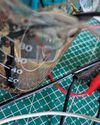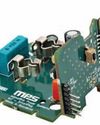WHY IS LIDAR ADOPTION SLOWER Than Expected?
Electronics For You
|May 2025
A decade of hype. Billions invested. But lidar still isn’t mainstream. What went wrong—and what does it mean for the future of autonomous vehicles?

Heralded as a breakthrough for the automotive industry’s shift towards safer, fully autonomous vehicles, lidar technology promises a future with zero road fatalities and enhanced accessibility. Despite a decade of extensive development, testing, and financial investments such as partnerships and acquisitions, lidar-equipped vehicles remain scarce on the roads. Known for its high-resolution 3D mapping and precise depth perception, lidar is essential for driverless cars but faces significant adoption challenges.
Although lidar delivers accurate data for autonomous navigation, several obstacles hinder its mainstream integration. High costs, technical limitations in various environments, complex data management, and competition from other sensor technologies have impeded its widespread use.
Despite its advantages in depth perception and detailed mapping, lidar confronts economic and technical barriers. Performance issues in adverse weather and the substantial investment required for deployment have made manufacturers and consumers cautious, slowing the technology’s adoption in the automotive sector.
The cost barrier to lidar adoption
Lidar technology, known for its precise point cloud mapping and high-resolution data, faces a significant adoption barrier due to its high cost. Lidar systems are substantially more expensive to produce and integrate than more economical sensors like cameras and radar. This cost disparity has kept lidar from becoming a mainstream option in the automotive industry, leading manufacturers to favour cheaper alternatives.
Challenges of creating 3D maps with lidar technology
- High costs and complexity. Collecting, processing, and storing lidar data is resource-intensive.
- Data ownership disputes. Companies, governments, and service providers often clash over rights to lidar data.
This story is from the May 2025 edition of Electronics For You.
Subscribe to Magzter GOLD to access thousands of curated premium stories, and 10,000+ magazines and newspapers.
Already a subscriber? Sign In
MORE STORIES FROM Electronics For You

Electronics For You
Tech Majors Are Racing TOWARDS NET-ZERO - What About You?
Apple, Microsoft, Amazon, Google, Infosys, Wipro—global and Indian firms are heading closer to achieving net-zero emissions, a mandate to combat climate change. Here is what you need to know to start your journey...
12 mins
December 2025

Electronics For You
Miniature IoT WATER TDS And LEVEL MONITOR Cum CONTROLLER
For setups that rely on stored water, clear awareness of tank level and water quality is essential.
3 mins
December 2025

Electronics For You
The Impact Of GENERATIVE AI On The Future Of AUTOMOTIVE AND EVs
Autonomous vehicles, connected ecosystems, and smart factories are only the beginning. Generative Al is pushing the auto industry beyond predictions into a bold era of creativity-from EV design to real-time diagnostics and showroom automation. Here is how GenAl is reshaping innovation across the automotive value chain.
8 mins
December 2025

Electronics For You
How AI Tools Are Making SOFTWARE DEVELOPMENT BETTER
AI is reshaping how we code, debug, and collaborate. From Copilot to automation, it is changing software development in ways worth exploring.
3 mins
December 2025
Electronics For You
How AI Tools Are Making SOFTWARE DEVELOPMENT BETTER
AI is reshaping how we code, debug, and collaborate. From Copilot to automation, it is changing software development in ways worth exploring.
3 mins
December 2025

Electronics For You
5 Interesting Reference Designs FOR SMART HOMES
Smart home devices are transforming the way people interact with their appliances. They make homes more convenient, secure, and energy-efficient. From smart plugs and energy monitors to smart locks and thermostats, reference designs help design engineers create connected products that are easy to use, consume less power, and are reliable. These designs allow you to control devices remotely, track energy use, extend battery life, and automate routines. They provide practical solutions for upgrading homes and small commercial spaces without major modifications.
3 mins
December 2025

Electronics For You
Fancy USB LED VASE
This USB LED vase is a simple yet elegant device that fuses art with electronics to create a decorative lighting display. Powered directly from a standard USB port, it uses readily available components such as MOSFETs, resistors, capacitors, and LEDs to produce a striking, dynamic sequence of lights.
3 mins
December 2025

Electronics For You
"WHAT OTHERS SELL IN FOUR BOXES WE BUILT IN ONE"
Years of custom field work are shaping a product line with its own cloud, its own hardware, and a market that is now beginning to recognise its value.
8 mins
December 2025

Electronics For You
BUILD LARGE LANGUAGE MODELS
Large language models are machine learning models designed for a range of language-related tasks such as text generation and translation. Here’s how open source software can help you build your own large language model.
6 mins
December 2025

Electronics For You
Rare Earth Or Rare Ingenuity? India Remains Between The Two
With China firmly controlling rare earth exports, India confronts a critical moment in its technological trajectory.
8 mins
December 2025
Listen
Translate
Change font size

